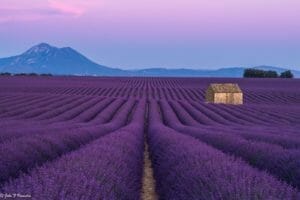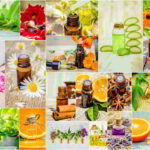
Harvesting Lavender conditions contribute to the quality of the distilled essential oil.
This means the season, climate, moisture levels, and even the amount of cloud coverage affects the quality of the finished product, as not all plants are hardy in all environments.
Soil quality is a major factor in the quality as well; a high amount of nitrogen in the soil, for instance, can promote disease in Lavender plants, causing them to appear sickly and leading to a decrease in flower growth.
Delicate or “tender” varieties of Lavender need to be kept warm and will not survive outdoors in the winter, thus needing to be potted and kept inside during this season in sunny locations with good air circulation. Despite their ability to tolerate heavy rains while still outside, they must be allowed adequate drainage, as they thrive in dry, hot sunny areas. High humidity makes Lavender plants susceptible to fungus growth, and for this reason good air circulation is imperative to their growth.
Lavender blooms vary in shapes and sizes and they grow on long spikes or stems. Their essential oils can be found in microscopic glands on the outside ring of flower petals (the calyx), the inside ring of flower petals (the corolla), the leaves, and on the stalks and branches.
There are various developmental stages for Lavender flowers, and the ideal time for harvesting Lavender essential oil is when the flowers are in full bloom, that is to say fully developed. At this stage, the flowers at the top of the stem will have already burst open, the lower half will begin to open up as well, and almost the entire flower head is open.
Harvesting Lavender
Before it fully matures means the oil will not retain as high a quality as it could potentially have. Whereas, the more shriveled the flower petals on the stem, the more volatile molecules it loses and the weaker the fragrance becomes.
The yield and the quality of the oil depends on the age of the Lavender bushes as well as the weather. The months of harvest are between the end of July through August and may take between four and ten days, after which the quality could diminish. It is important to plan a harvest at a time when the weather is the perfect balance – that is, bright and clear but not hot, cold, or too windy.
Some of these conditions would cause the oils to evaporate while others would inhibit the esters from developing in the plant, which would lead to harvest being delayed until the onset of warmer weather. The absence of esters in Lavender oil would mean that the oil would lose its fragrant and therapeutic properties such as its sedative and anti-spasmodic effects.
If harvested by hand, Lavender flower spikes can be cut using sickles or shears. If harvested commercially through a mechanized process, harvesters are driven through Lavender fields with blooming flowers and the stems are cut while the flowers are stored in a cart that will be taken to a distillery.
Some harvesting machine models feed the flowers into cartridges that can fit directly into the distiller, which contributes to a faster pace for harvesting. After being picked, the Lavender is distilled.

Get discount!
Enter your Email and you will get 15% discount coupon on your first order





